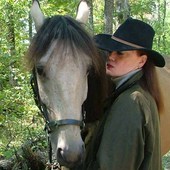For the past couple of years, I have been doing the newsletter for the Spruce Creek Trails Association and, as I ride on various trails in or around Big South Fork National Park, I have been taking pictures of wildflowers and putting them in each bi-monthly issue, so other riders can look for them on those trails in those months.
The camera in my BlackBerry is useful for this purpose but, after taking too many pictures of my pommel or my reins, I learned that I need to get off; my riding buddies don't even ask "What for?" now, when I leap off and say, "Hold my horse!"
 After one such ride, I MISTAKENLY identified as butterfly bush on Duncan Hollow Road a plant that is actually a noxious weed, considered a "nuisance plant." It is, in fact, Japanese spirea. It didn't take long for my friend, Sue Neff, a Landscape Architect (and Project Manager for Big South Fork when she worked for the Army Corps of Engineers) to advise me that I was wrong.
After one such ride, I MISTAKENLY identified as butterfly bush on Duncan Hollow Road a plant that is actually a noxious weed, considered a "nuisance plant." It is, in fact, Japanese spirea. It didn't take long for my friend, Sue Neff, a Landscape Architect (and Project Manager for Big South Fork when she worked for the Army Corps of Engineers) to advise me that I was wrong.
A "weed" is generally defined as a plant that is growing out of place or is unwanted where it is growing. Park botanists are concerned with plants that are exotic, that is, non-native species that were either intentionally or accidentally introduced, or are invasive. Invasive plants spread rapidly, competing with native species for light, for moisture and for essential nutrients and park managers must work to control them before they take hold and spread to other areas.
Other invasive "pest" plants in this area include purple loosestrife, multiflora rose, Japanese stiltgrass and, of course, the most infamous invader, Kudzu.
 Then there's the lovely mimosa, a hardy tree that is a popular ornamental with its fragrant and showy flowers...also considered a pest. Mimosa is native to Asia, from Iran to China, and it was introduced to the U.S. in 1745. Since then, it has established itself across much of the eastern and southern U.S.
Then there's the lovely mimosa, a hardy tree that is a popular ornamental with its fragrant and showy flowers...also considered a pest. Mimosa is native to Asia, from Iran to China, and it was introduced to the U.S. in 1745. Since then, it has established itself across much of the eastern and southern U.S.
It has very distinctive feathery, fernlike deciduous leaves and showy pink flowers, in bloom from May-August. Admirers will also notice the long flat pods, about 6" long, that contain the seeds, which remain on the trees well into the winter. Trees can reach heights of 20-40 feet.
Mimosa takes advantage of disturbed areas, often spreading by seed from ornamentals nearby or from seed brought in on fill dirt. It prefers full sun and is often seen along roadsides. It can tolerate partial shade but is seldom found in forests with full canopy cover or at elevations above 3,000 ft, where cold-hardiness is a limiting factor.
As with most invasive plants, it reproduces prolifically. Seeds sprout with ease and trees grow rapidly under good conditions but have weak, brittle wood and are short-lived. However, they re-sprout quickly if cut or top-killed and suckering is common after eradication attempts. Cutting is an initial control measure but requires either an herbicidal control or repeated cutting for re-sprouts. As an ornamental, it may seem appealing at first but it's an especially messy plant! The sticky, staining, brown paste formed by wet dropped blossoms is particularly obnoxious so positioning a mimosa over a walkway or driveway may not be such a good idea.
For information about Big South Fork real estate or horse properties in Jamestown, Tennessee, go to www.trailridersrealestate.com
There's also a lot of information about the are on Tennessee Recreational Properties' website.

Comments(6)